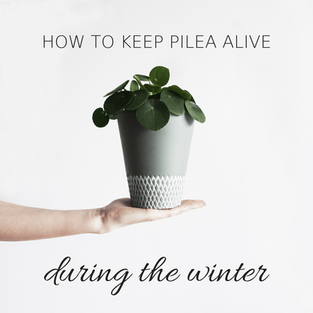How To Increase Humidity Around Your Pilea
- Dec 10, 2019
- 3 min read
Updated: Jun 29, 2020
As a tropical plant, Pilea Peperomioides loves humid environments. Unfortunately, most of the time our homes are on the dry side, particularly in the wintertime. Here are some easy ways to increase moisture levels so that your Pilea will thrive!
This article contains Amazon Affiliate links. The price of the products stays the same, we receive just a little bit in return. Earnings from qualifying sales will help keep Pilea.com up and running. Thank you so much for your support!Mist The Leaves Regularly
The simplest way to add a little humidity to your Pilea's surroundings is by misting its leaves with filtered or distilled water. A mister is a cost-effective and easy tool to increase humidity around the plant and depending on how dry your home is, you may need to mist several times a week. Always use a sprayer with a very light mist – never soak the plant entirely.
If you need to build up more humidity, it's probably best to get a humidifier.
Buy A Humidifier
Humidifiers are highly effective at bringing up humidity levels in the home.
They generally run in the $30-$250 price range and are typically categorized by the size of the room they'll be used in.
Choose a filterless humidifier filter that can be easily cleaned. Also, before buying, check the noise levels: if the humidifier is in a common area or a bedroom, you'll want to sit and relax without a constant noise going on.
Place your humidifier up higher and not directly on the floor: it will help avoid water damage or growth of mold in your home.
Create A Pebble Tray
A pebble tray consists of a tray lined with pebbles where you can place your Pilea.
It can be a wide shallow bowl, a plant saucer, or even a baking tray.
Pour water over the pebbles until it reaches just below the bottom of the pot. Don't place the pot in the water, but right on top of it. As the water in the tray evaporates, it will increase the moisture around the plant.
The pebbles will tend to grow algae and get dirty, so remember to keep an eye on them and clean your tray often.
Gather Your Plants
If you have enough plants, gather them together with your Pilea in a corner of your house or room. Doing this, that part of the room will become a bit more humid. Placing your houseplants in groups will also look terrific from a design perspective!
You can increase the humidity even more by placing a dish of water in the center of the cluster.
Move Your Pilea In The Bathroom
The bathroom is typically the most humid area of the home and provides for a perfect environment for Pilea.
If you have a bathroom with a North-facing window, fit your Pilea in there. The plant will enjoy the extra humidity, and your bathroom will look nicer!
Create A Terrarium
Terrariums are glass environments where moisture-loving plants tend to thrive. The contained environment helps increase the humidity around the plant as transpiration occurs from the plant's leaves. You can create a homemade terrarium by following this tutorial!
Remember
If your Pilea is not getting enough humidity, you may notice its leaf edges turning crisp and brown. Also, new leaves won't grow properly. The lack of moisture in your home is the reason why your skin gets dry, so just think how our green friend may feel!
Don’t place your Pilea near a radiator or other heat sources. Any leaves that touch a heater will get scorched, and humidity will be at its lowest. If you have underfloor heating, move your Pilea off the ground onto a table or plant stand. Make sure your Pilea is far from any doorways or corridors, as drafts will lower humidity and damage the plant.
Signs That Your Pilea Might Need Higher Humidity
Leaves develop brown edges
The plant begins to wilt
Leaves begin to yellow
Foliage becomes crispy
Keep Reading












Comments